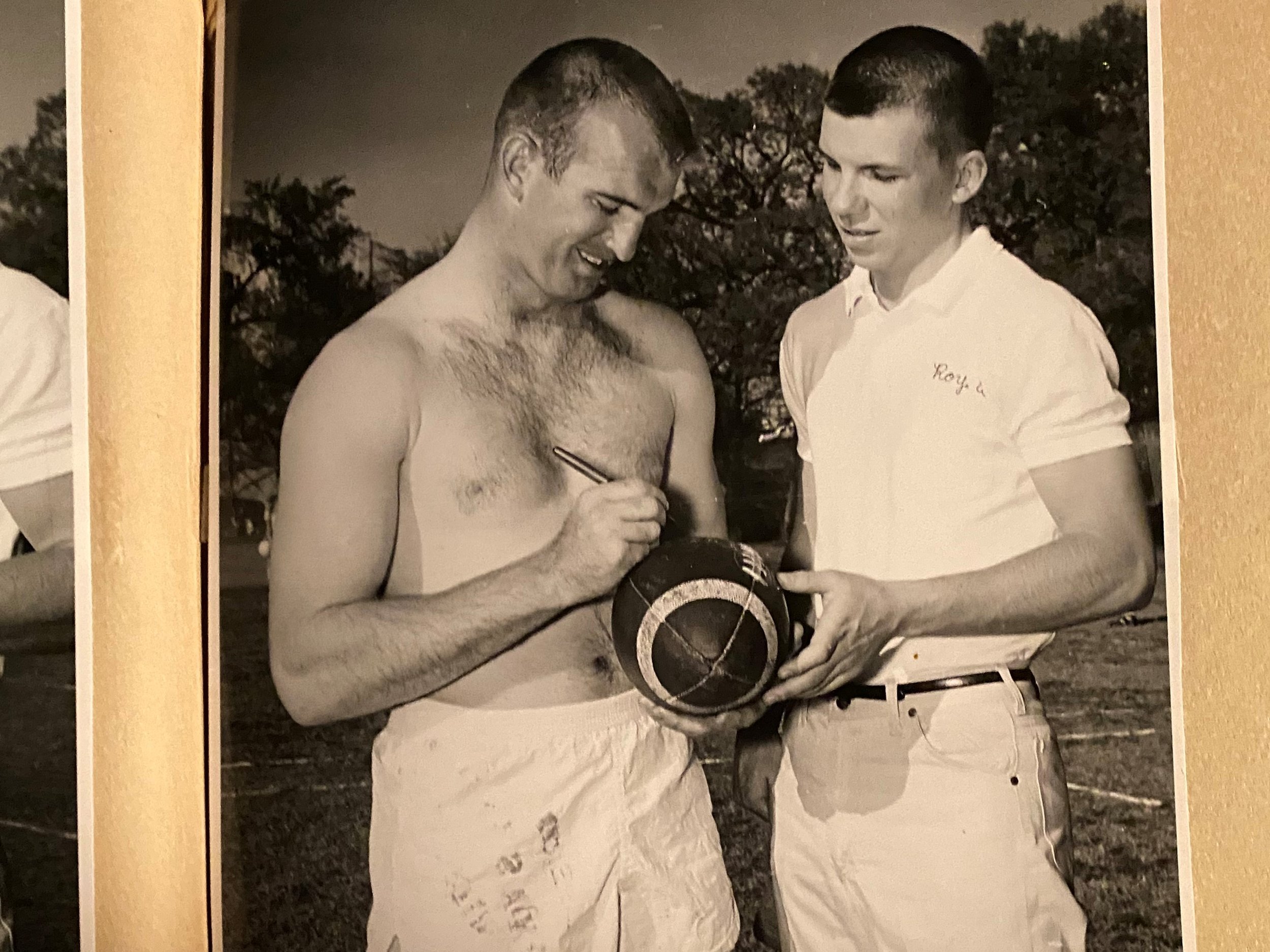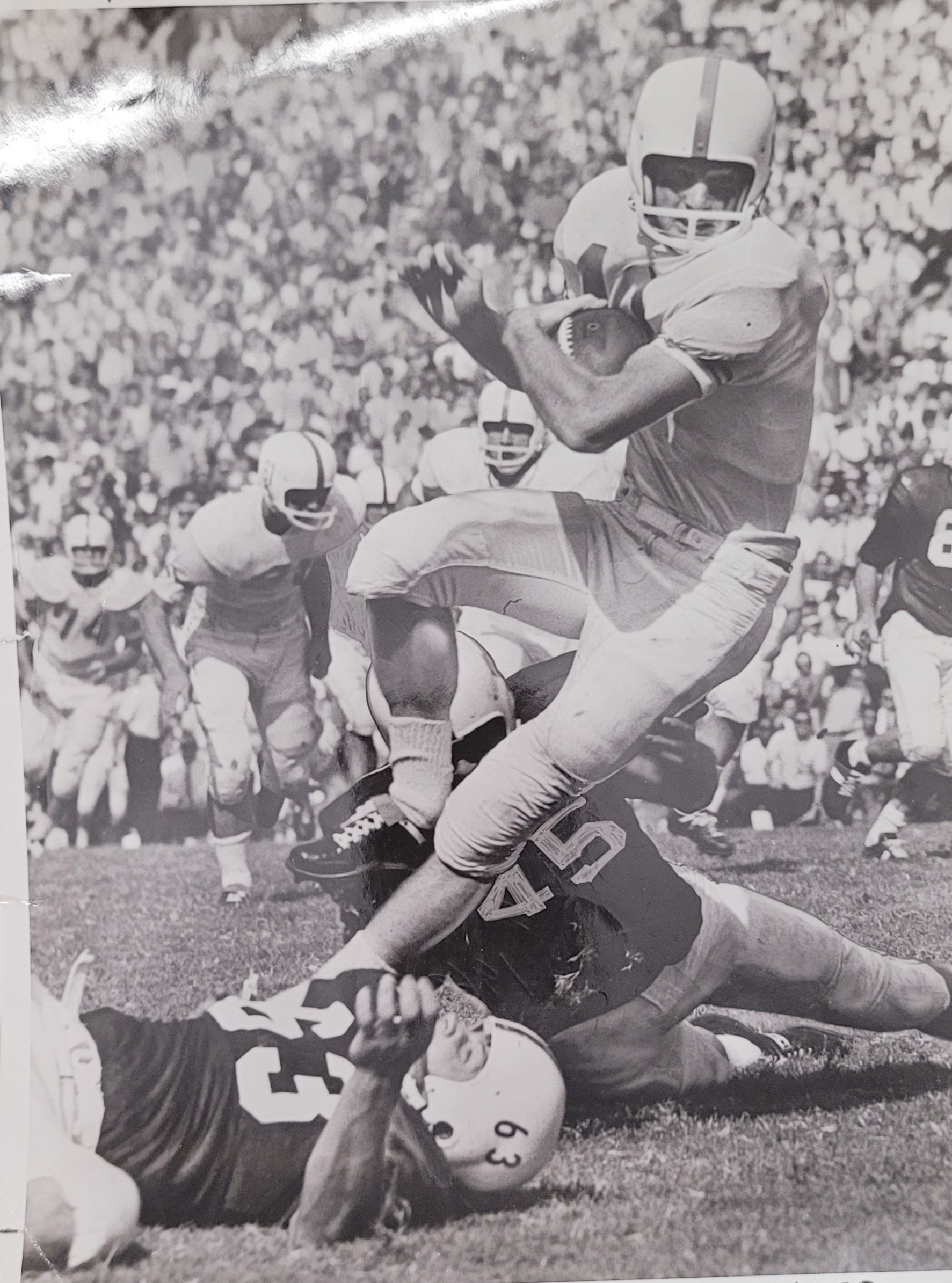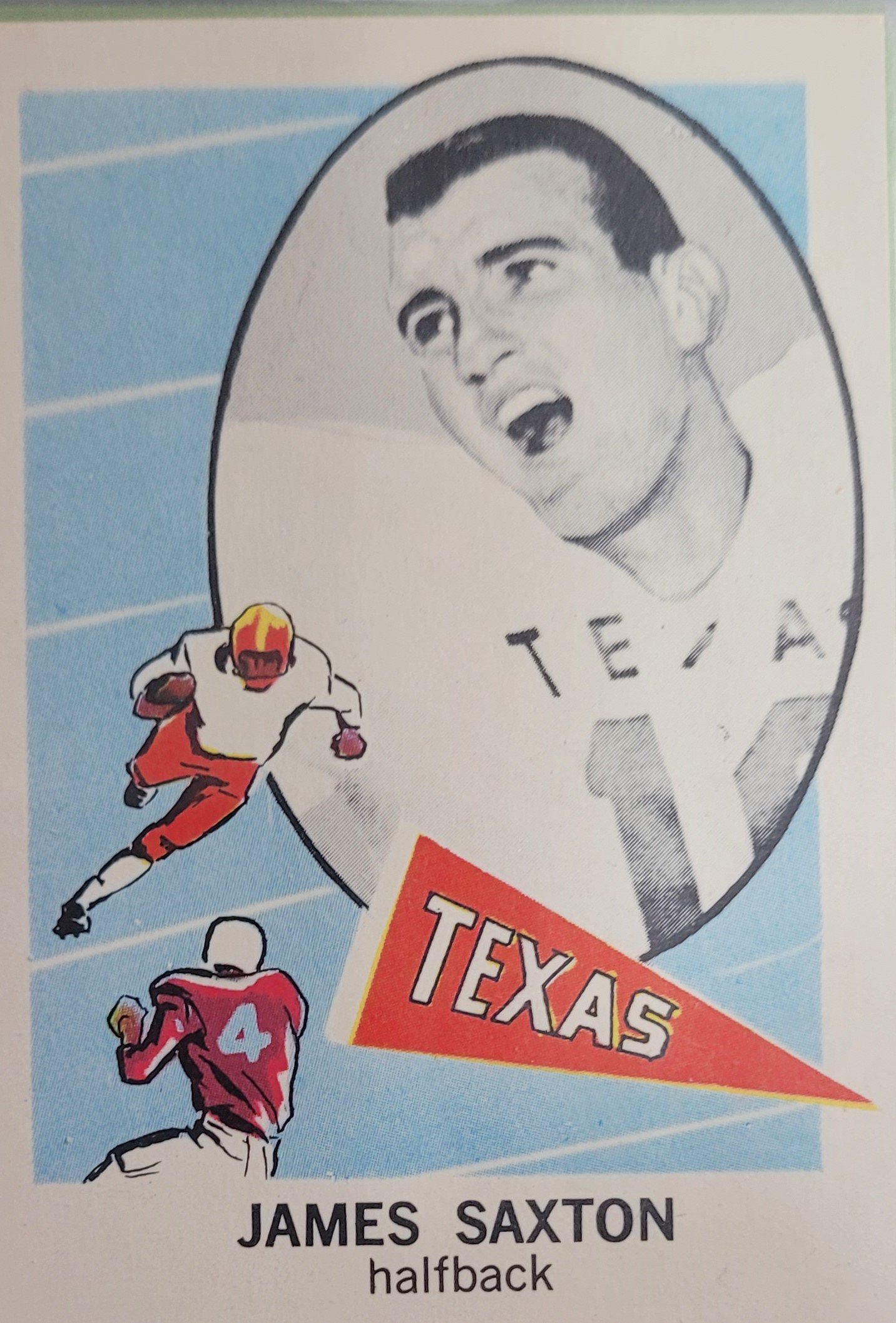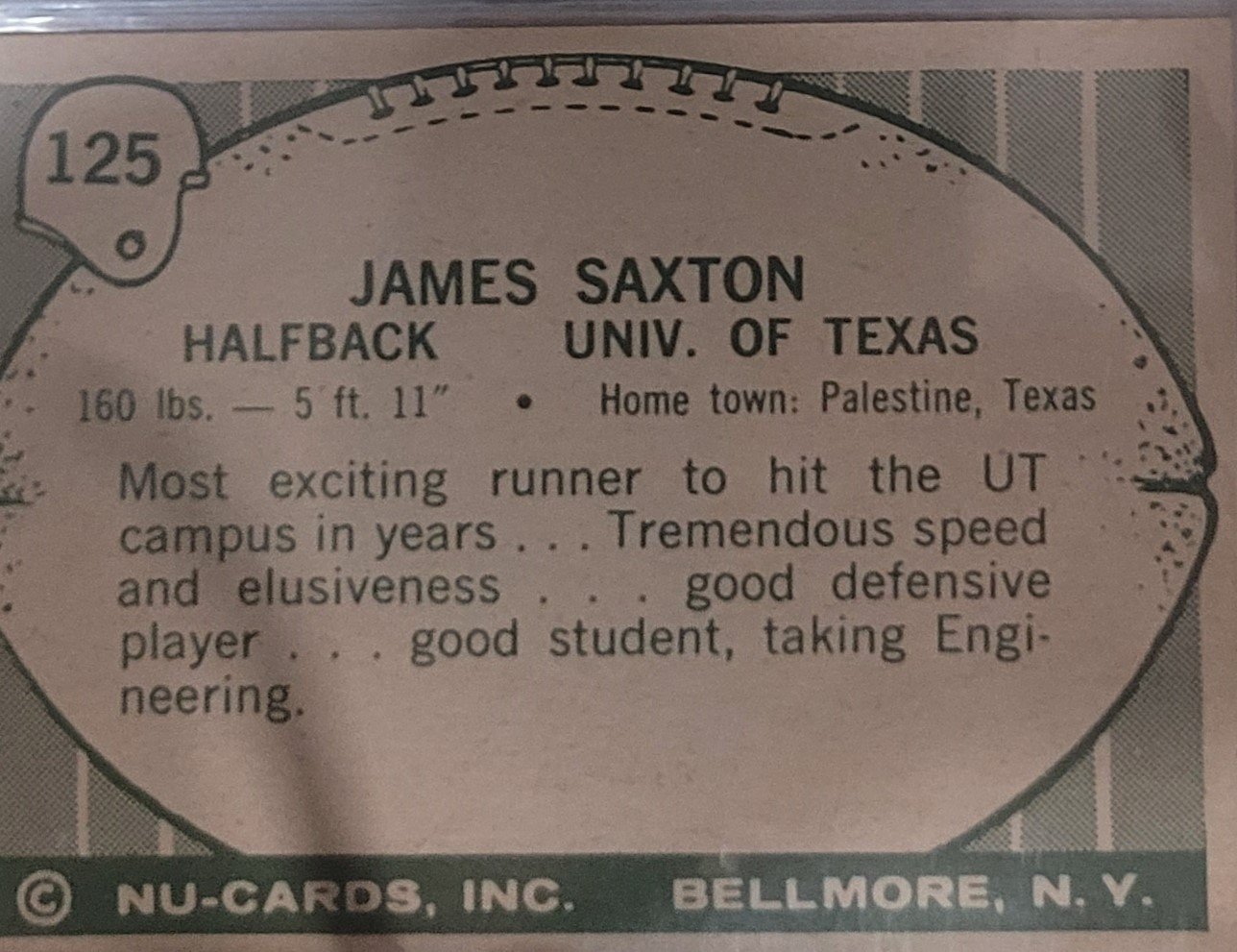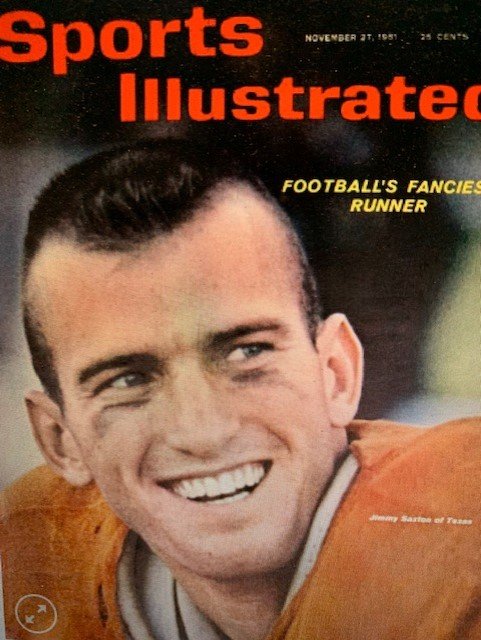Flashback to TCU 1961: DKR's, and Saxton's Most Painful Loss by Larry Carlson for TLSN https://texaslsn.org.
Was it just a case of an extremely unfortunate on-field accident? Or was it the cheap shot heard 'round the football world, the payoff lick of a TCU bounty hunt? Darrell Royal later called the upset loss to Texas Christian in November 1961, the toughest, hardest defeat he took as a coach. Jimmy Saxton, UT's first All-America running back, lost much more that cool, cloudy day. Saxton, a wispy 5-11, 160-pound package of speed, quickness and an uncanny ability to make people miss, got sucker-kneed in front of 60,000 fans. It would rob him of many things, but he played on, and five days later, he helped Texas to a 25-0 shutout of A&M. A Cotton Bowl win over Ole Miss came five weeks later, and Saxton went on to become a member of the 1962 AFL champion Dallas Texans. Later, Saxton was named to the Texas Hall of Honor and the College Football Hall of Fame. He was a successful Austin businessman for many decades and passed away in 2014. The Longhorn called "Football's Fanciest Runner" by Sports Illustrated, was the victim of the most infamous shot in UT history. If he did see the big blow coming, it was too late. Saxton had popped up after taking a swing pass 45 yards early in the game between top-ranked Texas and TCU, a 2-4-1 team. The Horned Frogs' big Bobby Plummer, all 220 pounds of him, came barreling in late and a full-speed knee smacked Saxton in the head. From Memorial Stadium's knothole section, my eight-year-old eyes saw what looked to be dirty football at its worst. I'll admit to bias but I don't think anyone in the stadium believed otherwise. Assisted by UT trainers, Saxton at last rose to great, relieved applause from what had been a very scared, hushed partisan Texas crowd. Saxton walked a few steps, then collapsed. Said Plummer, in post-game remarks, "I was trying to miss him." He did not succeed in that. But his team succeeded, pulling off the season's most shocking upset in a weird 6-0 verdict against the Longhorns. The number one team missed two field goals and managed nary a point in spite of three trips inside the ten-yard line and two more inside the thirty. And maybe Plummer was right on target, nefariously zeroing in for the kill shot. We shall never have a definitive answer but earlier this year, a confidential source shared with me something shocking. The reliable source, one long connected to UT, said Saxton had actually been warned that week by a relative attending TCU, that there was campus scuttlebutt in Fort Worth, of a bounty on the All-American boy. That source told me the relative, via a long distance phone call, reportedly warned his kin, advising him, "Be careful." Could that rumored bounty of so long ago confirm why Saxton, who returned to action after only a few minutes, and played well as per his custom, was knocked out again in the third period? Is it unthinkable that there was a real bullseye on the back of number ten in orange? Since Saxton was so hard to catch, almost impossible to truly mash, could it be that a defender's best tackle might be one in which the speedster was getting up from a play already whistled? There was no modern concussion protocol in that era but it was later confirmed that Saxton received two concussions against TCU. That day, he was cleared again to play, in much the same way players at all levels were regularly given the nod to resume what was often called "gridiron combat." Billy Schott was a nine-year-old ballboy for Texas in '61 and a future Longhorn placekicker ('72-'74). He recalled this week just how dazed UT's mega-star appeared to be on the sidelines. "I think it shocked the entire team, to the point that they couldn't muster up any inspired retaliation," Schott said. Some three decades after the game, Saxton -- who never went public with any blame, accusations or vitriol about the TCU game -- did share some thoughts from that dark day in '61, when he was interviewed by Austin sportswriter Kirk Bohls, for the 1993 book, "Long Live The Longhorns." Saxton referred to Plummer's big hit as "a shot that didn't need to be taken." He recalled that, mentally, he "slept through most of the game." The first questionable play, according to Saxton in the interview with Bohls, cost him 50 percent of the hearing in his right ear. He called it "a permanent hearing disability" that only worsened with time. Sports Illustrated's crew was on assignment that autumn week in Austin to report on the likely national championship team and its most radiant star (Saxton was still featured as cover boy on the next issue). SI's Roy Terrell wrote colorfully about the day, mostly about the flashy football player from the East Texas town of Palestine, the guy who honed his skills of quickness and elusiveness by dodging pines in the forests near his boyhood home. "TCU didn't stop Saxton; nobody stops Saxton," Terrell wrote, noting that though Saxton missed about 40 minutes of the contest, he gained 130 of UT's 200 yards in total offense. But it hardly mattered on a day when his Longhorns just could not score. Saxton was seldom available for duty near the goal. Terrell, the writer, termed Plummer's big hit, "the first accident." and Saxton, when interviewed, was the gracious sportsman. "There was nothing dirty about it," Jimmy said, "but boy, do those guys hit hard." The Horned Frogs' blows to the head might well have snatched the Heisman Trophy from Saxton. He finished third, behind consensus All-America backfield mates -- Ernie Davis of Syracuse and Ohio State's Bob Ferguson -- in what was then the closest Heisman balloting ever. Billy Schott, then that tiny sprout of a ballboy, recalled a "tomb-like" atmosphere in the UT locker room following the nightmarish afternoon, Saxton's final appearance at Memorial Stadium. "I saw tears flow from many of my heroes' eyes... a combination of sorrow, anger and despair that was unknown to me in my young life," Schott said. Sixty-two years ago, there was no television exposure for games like Texas-TCU, expected to be a landslide rout. And there were no replays, anyway. Tragically, protocol regarding concussions consisted largely of the ability to see and count fingers while briefly sidelined. No targeting fouls were cited, no ejections were part of the college landscape. Sometimes, dirty play happened. Sometimes it still does. But on November 18, 1961, what appeared to the naked eye to be a villainous act and what might possibly have been tempted by a financial bounty, cost the University of Texas a national title. And it cost UT's all-time breakaway runner infinitely more.
(TLSN's Larry Carlson teaches sports media at Texas State University. He is a member of The Football Writers Association of America.)



